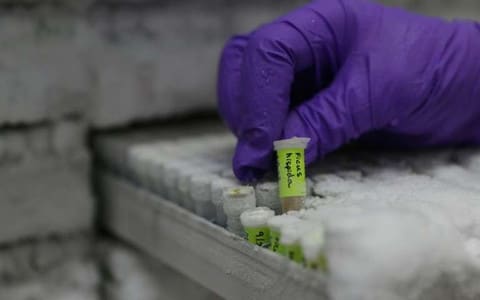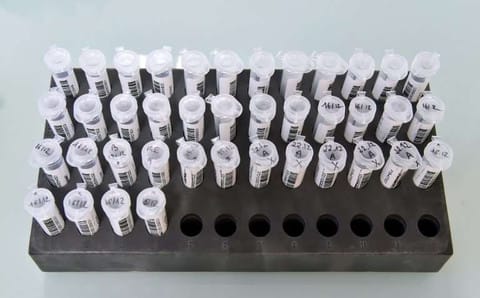2018年5月、DNAの最新研究により、ダーウィンの進化論が完全崩壊する、2つの衝撃的な事実が明らかになりました。
1.地球上に生息する生物種のうち、ヒトを含む全体の9割が20万年前~10万年前に出現したことが明らかになった。
2.生物種には明確な遺伝的境界があり、2つの種の間に位置する中間種はほぼ皆無だという研究結果が得られた。
ダーウィンの時代には 「見た目」で判断する選択肢しかなかったため、猿人が進化してヒトになったと推測されていました。
科学の進歩によりDNA検査でヒトの起源まで特定できるようになりましたが、
この結果が真実であれば、私たちが教科書で習ってきた進化論(自然淘汰、「中間」種の存在)は全て嘘だったということになります。
今回の研究結果から、20万年前~10万年前以前に存在した生命は、何らかの災難により「一掃された」とする仮説も浮上していますが、
恐竜の存在、太陽系を含む宇宙の成り立ちがプロパガンダであることが明らかになってきた今、ヒトを含む生命種の起源が10万~20万年前である可能性は、極めて高いと思われます。
関連ニュース1
ダーウィンの進化論を覆す? DNAの最新研究で分かったこと
<転載ここから>
現代の科学界で、当たり前のように唱えられているダーウィンの進化論。社会の授業で、「人間の祖先は700万年前に現れた猿です」と習う私たち。神の存在を全否定するために作られたこの理論を、根底から覆すような科学的データが報告された。
米ニューヨーク・ロックフェラー大学のマーク・ストークル氏(Mark Stoeckle)と、スイス・バーゼル大学のデビッド・タラー(David Thaler)氏は共同で、アメリカの遺伝子データバンク(GenBank)にある10万種の生物種の DNA から抽出された、500万の遺伝子断片である「DNA バーコード」を徹底的に調査した。
その結果、ほとんどの動物がヒトとほぼ同時期に出現したことを示す証拠を発見。人間を含む現在地球上に存在する生命種のうちの 90%が10万〜20万年前に出現したことが明らかになったという。
「驚くような結果でした。私自身、それに厳しく反論できるよう試みました」とタラ―氏は
AFPに話す。
この結果の証拠とするのは、いわゆる「中立な遺伝子変異」にばらつきがなかったこと。中立な遺伝子変異とは、世代を超えて生じる分子レベルでの微少な変化のことで、集団内でそれが固定化されることにより、分子進化が起こるという説。この遺伝子変異がどれくらい起こっているのかを調べることにより、その種が誕生したおおよその時期を特定できる。
地球上に存在する生命のほとんどは10万年から20万年前に、ほぼ同時期に現れたとすると、それより以前に存在した生命は、何らかの災難により「一掃された」とする仮説も成り立つ。
<転載ここまで>
関連ニュース2
「DNAバーコード」大規模解析、進化の新事実が浮き彫りに
<転載ここから>
2002年頃にカナダ人分子生物学者のポール・エベール(Paul Hebert)氏が、COI遺伝子の解析によって生物種を同定する方法を開発し、「DNAバーコード」という用語を考案した。
研究チームは今回、生物10万種のDNAバーコードを解析した結果、大半の動物がヒトとほぼ同時期に出現したことを示す明確な証拠を発見した。
研究チームが気付いたのは、いわゆる「中立」な遺伝子変異にばらつきがないことだった。中立変異は数世代を経て生じるDNAの微小な変化で、生物個体の生存可能性に対して有利にも不利にもならない。言い換えれば、進化を後押しする自然淘汰や性淘汰に関しては中立変異が無関係であることを意味する。
この中立突然変異に関して互いにどの程度、類似性があるかは木の年輪のようなもので、これを調べると一つの生物種のおおよその年齢が分かる。
ここで最初の疑問に立ち返る。現存する生物種の圧倒的大多数がほぼ同時期に出現した理由は何だろうか。
真の大量絶滅は、陸生恐竜と地球上の全生命の半数を死滅させた6550万年前の小惑星衝突を最後に起きていない。これは個体数の「ボトルネック効果」がせいぜい部分的な説明にしかならないことを意味している。
※ブログ主注略:地球が平面であるなら太陽系自体存在せず、小惑星衝突はなかったと考えられます。また恐竜が存在していなかったことは、数々のデータからほぼ明らかとなっています。
20.3.14追記
最新情報はこちらをご覧ください。→ 人間と恐竜(龍)は共存していた
「最も単純な解釈は、生命が常に進化を続けているということだ」と、ストークル氏は説明する。「進化においては常に、その時点で生きている動物が比較的最近出現した可能性の方が高い」
この観点から考えると、一つの種は一定の期間しか持続せず、その後は新種に進化するか、絶滅するかのどちらかだ。
今回の研究ではさらにもう一つ、予想外の結果が得られた。生物種には明確な遺伝的境界があり、2つの種の間に位置する中間種はほぼ皆無だという発見だ。
「個体が星だとすると、種はそれらが集まった銀河だ」とストークル氏は例えた。「種とは、何もない広大な遺伝子配列の宇宙空間に点在する、個体の星が凝集した星団だ」
「中間」種が存在しないこともまた、進化論を提唱した英自然科学者チャールズ・ダーウィン(Charles Darwin)を当惑させるだろうと、ストークル氏は話した。
<転載ここまで>
海外ニュースEvolution
Sweeping gene survey reveals new facets of evolution
May 28, 2018 by Marlowe Hood
Who would have suspected that a handheld genetic test used to unmask sushi bars pawning off tilapia for tuna could deliver deep insights into evolution, including how new species emerge?
And who would have thought to trawl through five million of these gene snapshots—called "DNA barcodes"—collected from 100,000 animal species by hundreds of researchers around the world and deposited in the US government-run GenBank database?
That would be Mark Stoeckle from The Rockefeller University in New York and David Thaler at the University of Basel in Switzerland, who together published findings last week sure to jostle, if not overturn, more than one settled idea about how evolution unfolds.
It is textbook biology, for example, that species with large, far-flung populations—think ants, rats, humans—will become more genetically diverse over time.
But is that true?
"The answer is no," said Stoeckle, lead author of the study, published in the journal Human Evolution.
For the planet's 7.6 billion people, 500 million house sparrows, or 100,000 sandpipers, genetic diversity "is about the same," he told AFP.
The study's most startling result, perhaps, is that nine out of 10 species on Earth today, including humans, came into being 100,000 to 200,000 years ago.
"This conclusion is very surprising, and I fought against it as hard as I could," Thaler told AFP.
That reaction is understandable: How does one explain the fact that 90 percent of animal life, genetically speaking, is roughly the same age?
Was there some catastrophic event 200,000 years ago that nearly wiped the slate clean?
Simpler, cheaper
To understand the answer, one has to understand DNA barcoding. Animals have two kinds of DNA.
The one we are most familiar with, nuclear DNA, is passed down in most animals by male and female parents and contains the genetic blueprint for each individual.

The genome—made up of DNA—is constructed with four types of molecules arranged in pairs. In humans, there are three billion of these pairs, grouped into about 20,000 genes.
But all animals also have DNA in their mitochondria, which are the tiny structures inside each cell that convert energy from food into a form that cells can use.
Mitochondria contain 37 genes, and one of them, known as COI, is used to do DNA barcoding.
Unlike the genes in nuclear DNA, which can differ greatly from species to species, all animals have the same set of mitochondrial DNA, providing a common basis for comparison.
Mitochondrial DNA is also a lot simpler, and cheaper, to isolate.
Around 2002, Canadian molecular biologist Paul Hebert—who coined the term "DNA barcode"—figured out a way to identify species by analysing the COI gene.
"The mitochondrial sequence has proved perfect for this all-animal approach because it has just the right balance of two conflicting properties," said Thaler.
'Neutral' mutations
On the one hand, the COI gene sequence is similar across all animals, making it easy to pick out and compare.
On the other hand, these mitochondrial snippets are different enough to be able to distinguish between each species.
"It coincides almost perfectly with species designations made by specialist experts in each animal domain," Thaler said.
In analysing the barcodes across 100,000 species, the researchers found a telltale sign showing that almost all the animals emerged about the same time as humans.
What they saw was a lack of variation in so-called "neutral" mutations, which are the slight changes in DNA across generations that neither help nor hurt an individual's chances of survival.
In other words, they were irrelevant in terms of the natural and sexual drivers of evolution.

How similar or not these "neutral" mutations are to each other is like tree rings—they reveal the approximate age of a species.
Which brings us back to our question: why did the overwhelming majority of species in existence today emerge at about the same time?
Darwin perplexed
Environmental trauma is one possibility, explained Jesse Ausubel, director of the Program for the Human Environment at The Rockefeller University.
"Viruses, ice ages, successful new competitors, loss of prey—all these may cause periods when the population of an animal drops sharply," he told AFP, commenting on the study.
"In these periods, it is easier for a genetic innovation to sweep the population and contribute to the emergence of a new species."
But the last true mass extinction event was 65.5 million years ago when a likely asteroid strike wiped out land-bound dinosaurs and half of all species on Earth. This means a population "bottleneck" is only a partial explanation at best.
"The simplest interpretation is that life is always evolving," said Stoeckle.
"It is more likely that—at all times in evolution—the animals alive at that point arose relatively recently."
In this view, a species only lasts a certain amount of time before it either evolves into something new or goes extinct.
And yet—another unexpected finding from the study—species have very clear genetic boundaries, and there's nothing much in between.
"If individuals are stars, then species are galaxies," said Thaler. "They are compact clusters in the vastness of empty sequence space."
The absence of "in-between" species is something that also perplexed Darwin, he said.
参考サイト
【衝撃】ダーウィンの進化論完全崩壊? 「ヒトを含む90%の生物種は20万年前に同時に誕生」研究で判明、生物博士が徹底解説!
「ダーウィンの進化論を否定」500人以上の有名科学者が表明!進化論支持派はまだ何も説明できていない!
YAHOO!知恵袋「人類の祖先は、本当に猿人なのですか?」






















